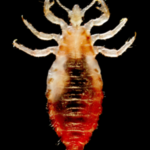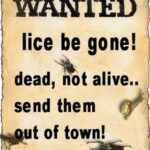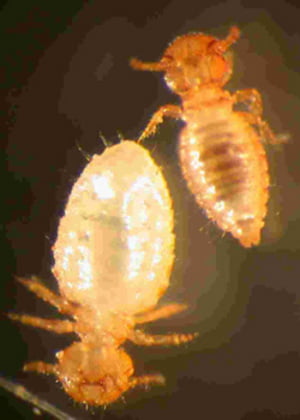If the title of this piece didn’t make you stop and scratch your head, just wait. If it did, it is most likely psychosomatic itching and not the presence of the parasitic little critters that evolve almost entirely on the scalp of the human head. Just in case you were wondering, according to my research, head lice do not jump or fly (phew!). It is out of compassion for mothers like myself that freak out at the thought of these nasty bugs, that I write this now. Through this experience, I learned more than I ever wanted to learn about head lice because of a recent bout that would not abate. Not for lack of trying, mind you. But, if one lice egg or one louse that lays eggs is overlooked you may be in for another round of infestation.
I begin my educational perusal of this subject with some friendly advice: calm down. It is NOT the end of the world! It’s not life threatening, either. You (and by you, I mean me) need not deposit your child into the bathtub and run around like a chicken with its head cut off. Don’t be embarrassed to call the school and tell them that the other children were exposed to lice. It’s really incredibly common, and according to both extremely patient nurses I spoke to on the Consulting Nurse hotline, it is increasingly more of an epidemic in this country. The other piece of information I was armed with was that the pests are actually becoming resistant to some of the types of pesticide shampoo usually used to kill them. Of course, upon the mention of the word “epidemic”, I was ready to hunt down a valium. Okay, not really, but it was awfully tempting!
I admit that it doesn’t seem very common. One of the nurses I spoke to said that if I was brave enough, I could ask around at the local Starbucks and just start asking random people about their experiences with it, I would find that it happens often enough that every person would have their own tale of lice woe. Most people are just too embarrassed to talk about it. I had to concede that I am indeed one of those people. When I was four or five, I remember my mom having to bag all the stuffed animals for one month and using the lice shampoo and lice comb on my sister and me. I don’t recall the washing of bedding, the vacuuming of all furniture and other things that occurred when she dealt with the problem. She had gotten lice from her hairdresser and subsequently gave it transferred to my sister and me. Makes you want to run out and get a hair appointment! Or at least wonder what hairdresser wouldn’t notice lice on a client. Ew.
Here is a short list of precisely what to do when lice are first discovered:
Treat the infested person(s) with the lice shampoo. Remove their clothing and wash immediately following the treatment. Wash all bedding, blankets, coats and clothing in hot water above 120 degrees. Use plastic garbage bags to store all stuffed animals and anything that cannot be laundered for a period of thirty days. Bedding and pillows may be put in the dryer for half an hour on high heat because the heat will kill any lice. Use the lice comb every day on the person who had lice for at least one month, to make sure you haven’t missed anything. Run all combs and brushes through the dishwasher or boil in hot water for five to ten minutes. Throw ponytail holders and other such hair things in the trash and purchase new ones.
I would also like to share some of the consistent advice I gleaned from a several health professionals.
Check EVERY PERSON in the household that may have been exposed to lice.
Lice do not gravitate to clean heads, dirty heads, or eschew heads with hair product. Their lifeline is the blood on the scalp of a human. They cannot transfer to animals, or come from animals. Pet fleas will bite humans, but that is the end of the human and pet-bug-sharing-extravaganza. Head lice easily spread by head-to-head contact, sharing combs and brushes, hats and coats hung together on a coat rack. It is less likely, but not entirely impossible, that an egg would end up on the floor and transfer to someone’s clothes and somehow miraculously arrive at Lice Nirvana: the human scalp. Do not skip being checked or checking someone because it merely seems unlikely that the individual in question might have head lice. Unfortunately, lice are just not that discriminating.
Buy the expensive Lice shampoo.
Word to the wise: do not treat someone that does not actually have lice! Repeated exposure to these toxic chemicals can cause brain damage. Your nurse or doctor will most likely tell you that, because I was informed of that particular at least four or five times by each nurse and the doctor I took my kids to. Lice will be evident by the presence of bugs crawling on the scalp, or lice eggs that are called nits. Nits are found on the shaft of the hair, and it will require effort to remove them from the hair. You will need a Nit comb, and usually a lice comb is provided with the Lice shampoo. I do not recommend scraping them off with your fingernails. Who wants a lice egg stuck underneath their fingernails? You can photographs of what you are looking for on websites like www.headlice.org. Lice are icky, but that’s it. I must tell you, at the end of our month of lice-o-rama if I found a hair with a nit I just ripped the whole hair out.
When treating an infested person with lice shampoo, after making sure that the problem has been correctly diagnosed, follow the directions EXACTLY as they are shown on the box. As a matter of personal opinion, and what I found to be generally recommended by health professionals, I think that Nix worked better than RID and that the comb that came with the Nix crème rinse was far superior. I didn’t find that there was a big difference in price. Use an entire bottle on each person’s head, or possibly half a bottle on a person with short hair, which the directions specify, but in a crisis certain things have a tendency to be overlooked. I’m not much of a details person, so that could be a personal problem. I skim the directions to get the gist, and then go for it. In case you were wondering, that approach didn’t really work with this problem.
Make sure that the following the lice shampoo treatment do not use conditioner (or mayonnaise, but I’ll get into that in a moment) because it might deactivate the pesticide. Also, consult a health professional before retreating, if live lice (not freshly hatched lice) 48 hours following treatment are still being found. This means that the pesticide did not work. Ask a health professional what to do in this case because of the toxic nature of the lice treatment. Continue re-combing through the hair to continue to ensure that all the nits have been removed, and that any freshly hatched bugs are also removed. They need to live for ten days before they begin laying eggs, so it is imperative to get them as quickly as possible.
To minimize the exposure, cover the person’s head with a shower cap while the treatment is on the head and have them sit in a well-ventilated area for the ten-minute time frame that the shampoo must be on the scalp. Also, hold your breath while applying the shampoo and run promptly into the next room to escape the fumes. Blecch!
Non-chemical lice treatments.
This is not a substitute for the initial chemical treatment. I did not want to treat my daughter again with the chemicals after the initial treatment, unless directed by her doctor. If I had known the vinegar would deactivate the pesticide, I would have chosen olive oil instead of mayonnaise, but I had just bought a ridiculous amount of mayonnaise because it was on sale. I use it every day on my husband’s sandwiches, so why not? I coated my daughter’s head with mayonnaise (you can use Crisco or vegetable oil, although olive oil was suggested the most). Massage it into the scalp and cover the head for thirty minutes with a plastic sack and carefully comb out the hair the way it is directed to after using the lice shampoo, in one-inch sections going carefully over each strand of hair.
I heard that it suffocated the lice, but my experience with this type of treatment was that it made the eggs and freshly hatched lice easier to find. Those little buggers never saw it comin’! I think that the oils fattened up the hair, and made the scalp a much more hostile environment because any live ones were found sitting on top of the hair, rather than on the scalp. I cut the hair with the bug on it off her head and deposited it into a cup of boiling hot water.
Also, lice do not wash out in the shower unless they are DEAD. Even then their carcasses have a tendency to stick around, so keep combing through the hair even if a louse does not seem immediately evident.
Vacuum, vacuum, vacuum.
This was the most consistent advice from health care professionals: lice sprays and powders do not work. We used bug bomb in our home to be on the safe side but that is not recommended either. I was told to vacuum, vacuum, vacuum and vacuum EVERY thing that is not a hard surface like linoleum or hard floors. Vacuum the nooks and crannies of your home, just in case. The eggs are resistant to the pesticide, and can live for 10-14 days off the human head. Once hatched, they can live 24-48 hours off the human head. Vacuum mattresses and living room furniture and the interior of your car and wash car seat covers. After each vacuum, change out the vacuum bag or empty the cylinder. That is imperative!
You do not need to cut it off.
This is purely a matter of preference. I cut my children’s hair because it was easier to run the lice comb through shorter hair, and it was time to cut it, anyway. My niece ended up with a buzz cut when the lice reappeared for the fourth time in a month. Lice are statistically more common in girls than in boys but I don’t think that it’s because their hair is shorter; shorter hair may make the lice easier to detect. While a new ‘do might seem like the thing to do, it’s not a necessity.
It will take ten days or so to make sure that it is really gone.
Unfortunately, there is no magic bullet for this problem. You may never figure out where the lice came from because it is one of life’s great mysteries. You can roughly figure out how long they have been there based on the size of the bug you find, but even that isn’t probably terribly accurate given that a mature louse could have crawled onto your child’s head from wherever it had fallen out of someone’s head at some secret, undisclosed location that only the louse knows. From my view, it seemed like that darn creature from whence-ever it came (I know whence-ever isn’t a word) was carefully plotting the demise of my sanity! Also, writing this and editing this piece was probably the most uncomfortable writing and editing experience of my life. I hope that my suffering has helped a mom somewhere, who is praying that this NEVER happens or that this is happening to. It’s okay to get angry. It’s okay to be overwhelmed. It’s okay to be grossed out. What I had to do was just get myself in check and clean up the mess.
Be sure to get advice from a health care professional lice are discovered! I can assure you that you will most likely get some conflicting information if you ask around enough, but focus on the basics: treat the problem immediately, wash everything in hot water or put what cannot be washed in the dryer on high heat for at least half an hour and bag everything right away. Focus on the fact that while this problem is a nuisance, it is not a health hazard. Check with your child’s school to determine whether or not they have a ‘No Nits’ policy, barring your child from returning to school until all the nits have been removed. It is not the end of the world. It’s gross, but at the end of it all, my house was VERY clean.




